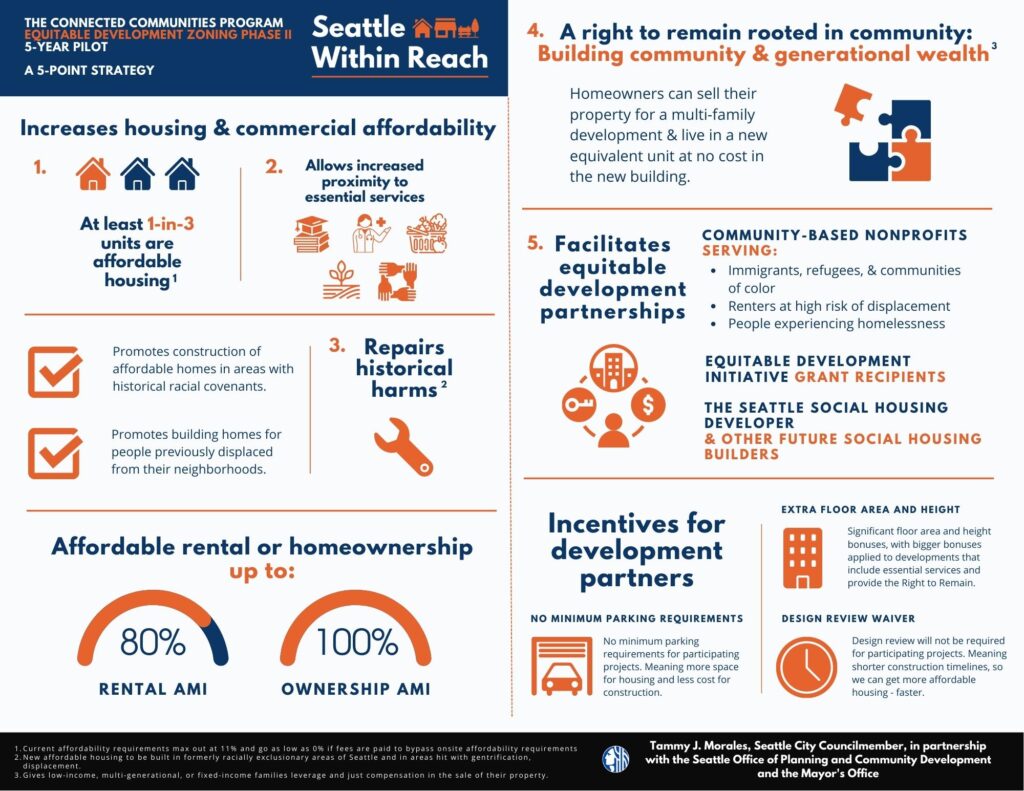Summary
Councilmember Tammy J. Morales is working with a large coalition of community stakeholders and the Office of Planning and Community Development (OPCD) to launch Phase II of Equitable Development Zoning, which is the City’s effort to align land use policy more closely with equitable development goals.
Seattle, WA – Councilmember Tammy J. Morales (District 2, International District and South Seattle) is working with a large coalition of community stakeholders and the Office of Planning and Community Development (OPCD) to launch Phase II of Equitable Development Zoning.
How It Works
Equitable Development Zoning (EDZ) is the City’s effort to align land use policy more closely with equitable development goals. Earlier this month, the City Council adopted, and Mayor Harrell signed, OPCD’s EDZ Phase I legislation, which removes regulatory barriers to small institution uses, which projects funded by the Equitable Development Initiative (EDI) often include. Equitable Development Zoning Phase II, known as the Connected Communities Development Pilot, presents a 5-point strategy to equitably increase density, set a new precedent for onsite affordable housing construction, and build a Seattle Within Reach by clearing hurdles for essential services in areas across the city.
The Connected Communities Development Pilot will:
- Create a way for small community or culturally based organizations seeking the opportunity to develop housing and/or commercial space to partner with larger non-profit, private, or public developers to include Equitable Development Initiative projects and onsite affordable housing in projects currently infeasible.
- Require a minimum of 30% of units in new market-rate developments for affordable rental and homeownership opportunities.
- Build affordable housing in areas of the city with historical racially exclusive covenants – areas with the lowest level of affordable multifamily homes today – while continuing to increase affordable housing stock in areas of high displacement.
- Allow increased proximity to equitably developed everyday goods and services like healthcare, educational facilities, cultural anchors, commercial kitchens, urban farms, and more.
- Prevent predatory homebuying by providing low-income and fixed-income families a way to sell their property for income-diverse multifamily development while gaining a new high-quality home onsite at no cost, allowing families to stay rooted in community and build generational wealth.
Community co-creation on the concept of Equitable Development Zoning and the Connected Communities Development Pilot has taken place over several years, with more than 40 community organizations, advocates, and leaders participating. Legislation to codify this phase of the strategy is expected to be introduced in September.
Quotes
CM Morales: “As a community organizer and neighborhood planner, I fought for the Equitable Development Initiative (EDI) because I saw our communities in the South End struggling to stay rooted and secure funding for community-led projects. Now, we can take our work to the next level. The Connected Communities Development Pilot is the next step toward building a Seattle Within Reach and I’m excited to take that step alongside the Office of Planning and Community Development and Mayor Harrell.”
OPCD, Director Quirindongo: “We look forward to collaborating with Councilmember Morales on a second phase of our Equitable Development Zoning effort that expands our support for community-based anti-displacement projects. Through this pilot and with our EDI partners, we will explore new ways to provide targeted support to equitable development projects and move towards land use and zoning rules that help our diverse communities stay in place and flourish as Seattle evolves. We thank CM Morales for her partnership on this important work.”
###
Background
EDI was established in 2016 to address the financial barriers that community-driven anti-displacement projects must overcome. Since then, dozens of community-led efforts to strengthen cultural networks, stabilize communities, and increase access to opportunity have received funding, obtained permits, and begun construction with the support from EDI.
But many equitable development projects continue to face with regulatory hurdles as they navigate the City’s land use and zoning rules. Phase I legislation adopted in July 2023 reduced barriers to the community-oriented uses like gathering space, arts and cultural facilitates, or educational programming that EDI projects often include. In the City’s land use rules, these activities are considered an “institution” use, which often requires a conditional use permit. As a result, community organizations have had to navigate permitting requirements that increase complexity, add cost to projects already on shoestring budgets, and require specialized real estate and development expertise that community organizations undertaking development for the first time typically don’t have.
Zoning restrictions further limit the viability of affordable housing and equitable development projects in many areas of Seattle. Given the high cost, competitiveness, and commodification of real estate, community-based organizations working to prevent displacement in high-risk areas often struggle to find, acquire, and hold onto land with suitable zoning where their projects are feasible. By integrating
EDZ strategies developed with stakeholders over the last two-plus years and coupled with other actions like permitting support and new policy in the forthcoming One Seattle Comprehensive Plan, the Connected Communities Development Pilot can help address these challenges.


